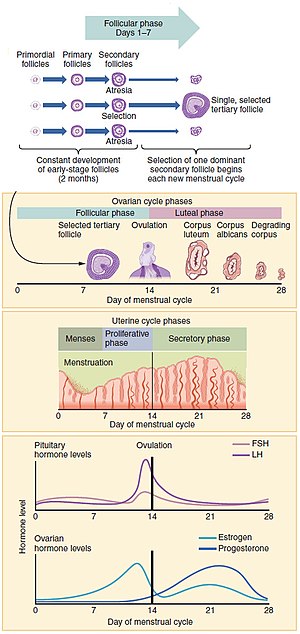- The science of measuring forest stands, including rate of growth and potential yield of standing timber, is called mensuration
- the calculation of geometric quantities such as length, area, and volume from dimensions and angles that are already known
- periodic vaginal discharge in humans and other mammals, consisting of blood and cells shed from the endometrium, or lining of the uterus . Menstruation accompanies a woman's childbearing years, usually beginning between the ages of 10 and 16, at puberty, and most often ceasing between the ages of 45 and 50, at menopause. Menstruation is part of the process that prepares a woman for pregnancy. Each month the lining of the uterus thickens; if pregnancy does not occur, this lining breaks down and is discharged through the vagina. The three to seven days that menstruation lasts is called the menstrual period.
- thanxxx and no thumbs up plzzz ( this is only for that faker)
.
- 5
periodic vaginal discharge in humans and other mammals, consisting of blood and cells shed from the endometrium, or lining of the uterus . Menstruation accompanies a woman's childbearing years, usually beginning between the ages of 10 and 16, at puberty, and most often ceasing between the ages of 45 and 50, at menopause. Menstruation is part of the process that prepares a woman for pregnancy. Each month the lining of the uterus thickens; if pregnancy does not occur, this lining breaks down and is discharged through the vagina. The three to seven days that menstruation lasts is called the menstrual period.
- 0
Menstruation
From Wikipedia, the free encyclopediaJump to navigationJump to search
This article is about menstruation in humans. For menstruation in other mammals, see Menstruation (mammal).

Figure showing the progression of the menstrual cycle and the different hormones contributing to it.
Menstruation, also known as a period or monthly,[1] is the regular discharge of blood and mucosal tissue (known as menses) from the inner lining of the uterus through the vagina.[2] The first period usually begins between twelve and fifteen years of age, a point in time known as menarche.[1] However, periods may occasionally start as young as eight years old and still be considered normal.[2] The average age of the first period is generally later in the developing world, and earlier in the developed world.[3] The typical length of time between the first day of one period and the first day of the next is 21 to 45 days in young women, and 21 to 31 days in adults (an average of 28 days).[2][3] Bleeding usually lasts around 2 to 7 days.[2] Menstruation stops occurring after menopause, which usually occurs between 45 and 55 years of age.[4] Periods also stop during pregnancyand typically do not resume during the initial months of breastfeeding.[2]
Up to 80% of women report having some symptoms prior to menstruation.[5] Common signs and symptoms include acne, tender breasts, bloating, feeling tired, irritability, and mood changes.[6] These may interfere with normal life, therefore qualifying as premenstrual syndrome, in 20 to 30% of women.[5] In 3 to 8%, symptoms are severe.[5]
A lack of periods, known as amenorrhea, is when periods do not occur by age 15 or have not occurred in 90 days.[2] Other problems with the menstrual cycle include painful periods and abnormal bleeding such as bleeding between periods or heavy bleeding.[2] Menstruation in other animals occur in primates (apes and monkeys).[7][8]
The menstrual cycle occurs due to the rise and fall of hormones.[2] This cycle results in the thickening of the lining of the uterus, and the growth of an egg, (which is required for pregnancy).[2] The egg is released from an ovary around day fourteen in the cycle; the thickened lining of the uterus provides nutrients to an embryo after implantation.[2] If pregnancy does not occur, the lining is released in what is known as menstruation.[2]
Onset and frequency

Diagram illustrating how the uterus lining builds up and breaks down during the menstrual cycle.
The first menstrual period occurs after the onset of pubertal growth, and is called menarche. The average age of menarche is 12 to 15.[1][9]However, it may start as early as eight.[2] The average age of the first period is generally later in the developing world, and earlier in the developed world.[3] The average age of menarche has changed little in the United States since the 1950s.[3]
Menstruation is the most visible phase of the menstrual cycle and its beginning is used as the marker between cycles. The first day of menstrual bleeding is the date used for the last menstrual period (LMP). The typical length of time between the first day of one period and the first day of the next is 21 to 45 days in young women, and 21 to 31 days in adults (an average of 28 days).[2][3]
Perimenopause is when fertility in a female declines, and menstruation occurs less regularly in the years leading up to the final menstrual period, when a female stops menstruating completely and is no longer fertile. The medical definition of menopause is one year without a period and typically occurs between 45 and 55 in Western countries.[4][10]:p. 381
During pregnancy and for some time after childbirth, menstruation does not occur. The average length of postpartum amenorrhoea is longer when breastfeeding; this is termed lactational amenorrhoea.
- 1
- 2
- 0
1. Menstrual phase - day 1-5
The wall of uterus breakdown and maturation occur
2. Preovulatory phase- day 6-13
proliferation of the uterine wall it becomes thick by cell division
3. Ovulatory phase- day 14
Release of ovum or egg
4. Post ovulatory phase- day 15 - 28
Uterine glands produce increase amount of watery mucus such a uterine wall is necessary for the implantation of the fertilized egg.
These are the faces of menstruation
Hope you understand
- 0


